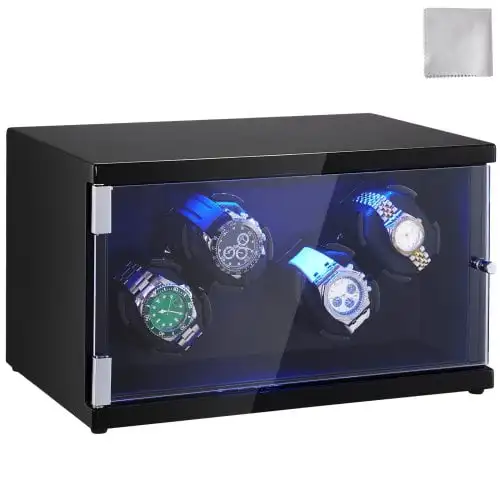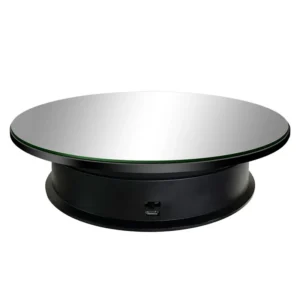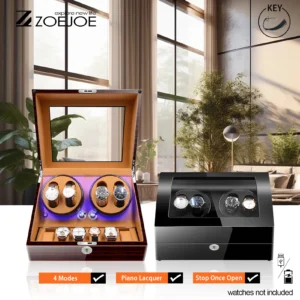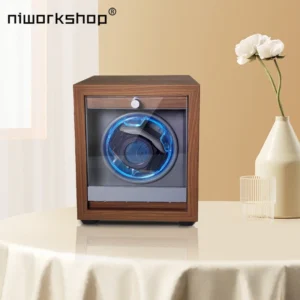Introduction: The Essential Role of Watch Winder Programming
Automatic watch winders are specialized devices designed to keep self-winding watches running when they’re not being worn. These ingenious machines mimic the natural motion of your wrist, gently rotating your timepiece to maintain the power reserve and keep it ticking accurately.
Programming your watch winder correctly is far more important than many collectors realize. When properly configured, a watch winder:
- Ensures your watch maintains accurate timekeeping
- Prevents lubricants inside the movement from settling and congealing
- Extends the lifespan of your automatic watch’s internal components
- Keeps complicated functions like date displays and moon phases current
Conversely, incorrect settings can lead to problems that range from inconvenient to potentially damaging:
- Insufficient winding may leave your watch without enough power reserve
- Excessive winding wastes electricity and causes unnecessary wear on your winder
- Incorrect rotation direction might result in inefficient winding
The correct programming of your automatic watch winder involves understanding three key parameters: Turns Per Day (TPD), rotation direction, and rest intervals. Each of these settings plays a crucial role in properly maintaining your timepiece.
Throughout this guide, we’ve researched manufacturer specifications and best practices to bring you comprehensive, accurate information on how to program your watch winder for optimal performance. Let’s dive into each parameter to ensure your cherished timepieces receive the care they deserve.
Understanding Turns Per Day (TPD): The Fundamental Setting
Turns Per Day (TPD) is the most crucial setting on your watch winder. This value represents the total number of complete 360-degree rotations your winder performs in a 24-hour period. Think of TPD as the “exercise regimen” for your watch – it determines how much movement your timepiece receives each day.
The primary function of TPD is to maintain optimal tension in your watch’s mainspring. The mainspring is the power source in mechanical watches, storing energy that gradually releases to power the movement. When an automatic watch is worn, your natural wrist movements spin an internal rotor that winds this mainspring. Your watch winder replicates this motion when the watch isn’t on your wrist.
Most automatic watches require between 650-900 TPD to maintain full power. However, this range varies significantly based on the watch’s specific movement design:
- Entry-level automatic watches typically require 650-800 TPD
- Mid-range watches with enhanced power reserves may need 750-900 TPD
- High-end watches with specialized movements might require anywhere from 500-1,300 TPD
Setting your TPD incorrectly can lead to suboptimal performance. If the TPD is too low, your watch won’t receive sufficient winding to maintain its power reserve, potentially causing it to stop or lose accuracy. If the TPD is too high, you’re simply causing unnecessary operation of your winder’s motor. Contrary to some misconceptions, excessive TPD typically won’t damage modern watches, as most have mechanisms to prevent overwinding.
The required TPD varies based on several factors in your watch’s design:
- Power reserve duration (how long the watch runs when fully wound)
- Rotor efficiency (how effectively the internal weight converts motion to winding)
- Movement manufacturer specifications (different calibers have different requirements)
- Age and service condition of the movement
For precision in maintaining your collection, consulting the watch winder TPD settings guide for your specific timepieces is highly recommended. This foundational understanding of TPD sets the stage for exploring the equally important directional settings.
Winding Direction Settings: Clockwise, Counter-Clockwise, or Bi-Directional
The second critical programming parameter for your watch winder is the rotation direction. Watch winders typically offer three directional settings, each serving a specific purpose based on your watch’s internal mechanism design:
Clockwise (CW): When facing the watch, the winder rotates in the same direction as a clock’s hands. This setting is appropriate for watches that wind exclusively through clockwise rotor movement.
Counter-Clockwise (CCW): The winder rotates opposite to the direction of a clock’s hands when facing the watch. Some watch movements are designed to wind only when the rotor spins in this direction.
Bi-Directional (BD): The winder alternates between clockwise and counter-clockwise rotations, typically changing direction after completing a set number of turns. This is the most versatile setting and works for watches that can wind from rotor movement in either direction.
The required direction setting depends entirely on how your watch’s automatic winding mechanism is designed. Most modern automatic watches wind bi-directionally, meaning they can harness energy from the rotor’s movement in either direction. However, some movements—particularly vintage ones or certain specialized calibers—wind exclusively in one direction.
In a bi-directional winding cycle, the winder typically completes a set number of rotations clockwise, pauses briefly, then reverses to complete the same number counter-clockwise. This alternating pattern continues throughout the winding period, efficiently maintaining power reserve for watches that can wind in both directions.
One common misconception is that using the wrong direction setting will damage your watch. In reality, setting an incorrect direction typically results in ineffective winding rather than mechanical damage. Your watch simply won’t receive the winding it needs to maintain its power reserve.
For comprehensive guidance on determining the optimal rotation direction for your specific timepiece, consult our ultimate guide to automatic watch winder settings or review the best automatic watch winder settings for your collection.
Rest Interval Programming: Optimizing Winding Cycles
Beyond TPD and direction settings, advanced watch winders offer the ability to program rest intervals—periods when the winder temporarily pauses rotation. These intervals, also called duty cycles, play a subtle but important role in optimizing your automatic watch’s maintenance.
Rest interval programming offers several significant benefits:
- More accurately mimics natural wearing patterns, as your wrist doesn’t move continuously throughout the day
- Reduces unnecessary motor operation, extending the lifespan of your watch winder
- Allows for more natural power distribution to the mainspring
- Decreases power consumption and associated costs
A typical rest period pattern might involve 2 hours of rotation followed by 6 hours of rest. This cycle more closely resembles how a watch would experience motion while being worn during daily activities, with periods of activity interspersed with periods of stillness.
When programming rest intervals, you have two fundamental approaches:
- Continuous rotation: The winder operates without breaks until it completes the daily TPD requirement
- Intermittent rotation: The winder distributes the TPD throughout the day in scheduled intervals
For most collectors, intermittent rotation offers the most benefits. It’s gentler on both your watch and winder while still maintaining optimal power reserve. Many higher-end winders come pre-programmed with scientifically designed rest intervals based on research into natural wearing patterns.
Some advanced winders allow you to customize not only the duration of rest periods but also their frequency throughout the day. This level of customization enables you to create winding patterns that perfectly match your specific watch’s needs.
For detailed information on determining the ideal rest intervals for your timepieces, our guide to optimal watch winder settings provides comprehensive recommendations based on movement types and wearing habits.
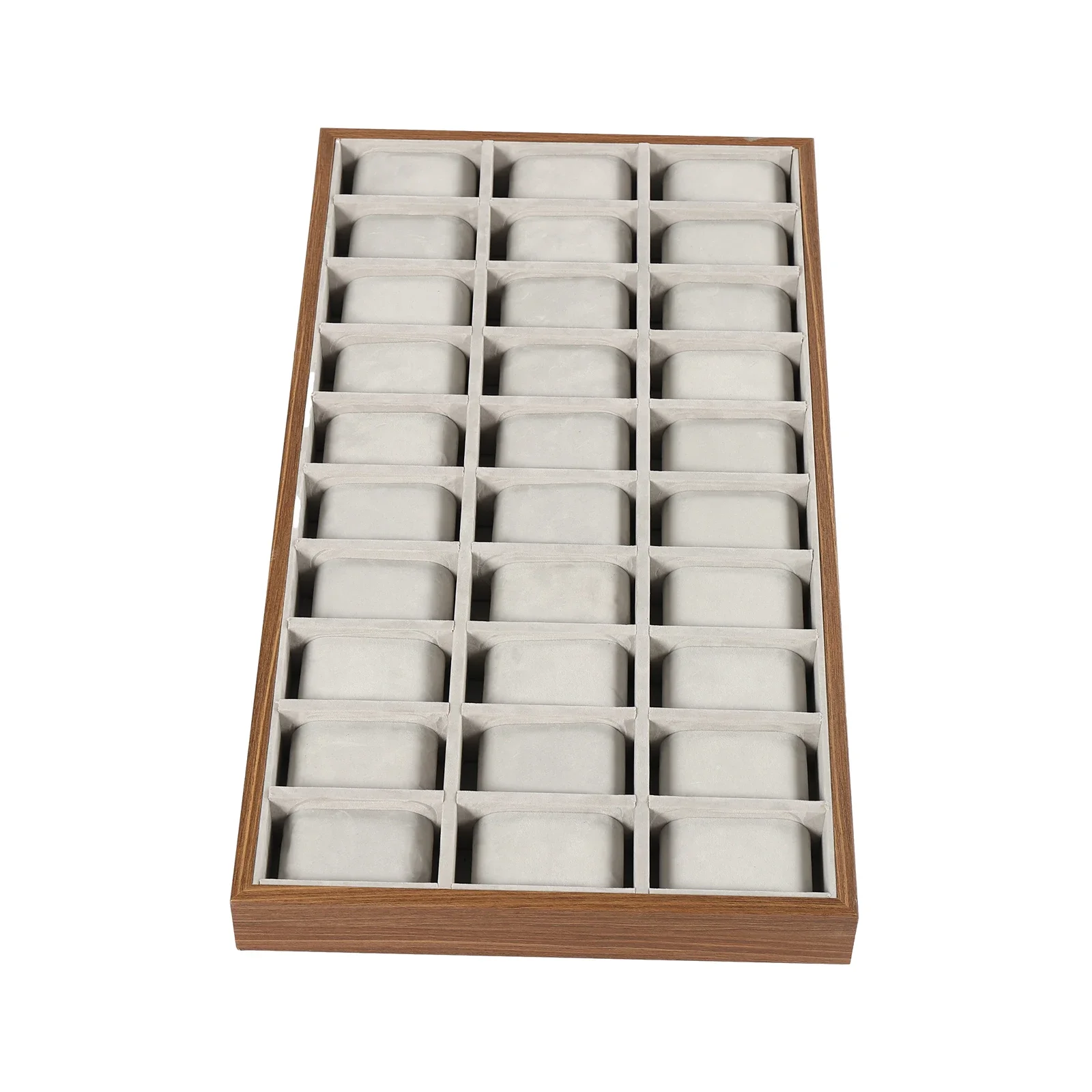
Finding Your Watch’s Ideal Settings: Research Methods
Determining the correct settings for your specific watch is crucial for optimal performance. Follow this hierarchy of reliable information sources to find the most accurate settings:
Watch Manufacturer Documentation: Always start with the official source. Check your watch’s manual, the manufacturer’s website, or contact their customer service directly. These official specifications provide the most reliable guidance.
Watch Winder Brand Databases: Many reputable winder manufacturers maintain comprehensive databases of recommended settings for popular watch brands and movements. These databases typically include TPD requirements and directional preferences.
Watch Enthusiast Forums and Communities: Online communities like WatchUSeek, Reddit’s r/Watches, or Timezone often have threads discussing specific setting requirements. Fellow collectors with the same watch model can share their successful settings.
Movement Manufacturer Guidelines: If you know your watch’s movement (e.g., ETA 2824-2, Sellita SW200), you can search for that specific caliber’s winding requirements, which often apply across multiple watch brands using the same movement.
When searching for manufacturer specifications, look for terms like “automatic winding direction,” “rotor winding,” or the specific caliber number plus “winding requirements.” Information might be presented in technical terms, such as “bi-directional winding via central rotor” or “uni-directional winding system.”
If you cannot find definitive information for your specific watch, start with conservative settings:
– Choose a moderate TPD setting (around 650-750)
– Select bi-directional rotation if available
– Implement reasonable rest periods (e.g., 2 hours on, 6 hours off)
For vintage watches, extra caution is warranted. These timepieces often have more delicate mechanisms and may benefit from lower TPD settings. Watches with complications such as perpetual calendars or moon phases have special considerations as well, as keeping these functions running can require specific winding protocols.
Our guide to watch winder compatibility provides more detailed research strategies for determining the perfect settings for your collection. For valuable timepieces, investing in a luxury watch winder with precise programming capabilities ensures proper care for your investment.
Reference Chart: Common Watch Brands and Their Recommended Settings
The following reference table provides general guidance for popular watch brands and movements. While these settings work for most models from these manufacturers, always verify with your specific watch’s documentation when possible.
| Brand/Model | Movement Type | TPD Range | Direction | Notes |
|---|---|---|---|---|
| Rolex | Various In-house | 650-800 | Bi-directional | Modern models generally wind efficiently at lower TPD |
| Omega | Co-Axial | 800-900 | Bi-directional | Co-Axial movements typically benefit from higher TPD |
| Seiko | 7S26, 4R35, 6R15 | 650-800 | Bi-directional | Robust movements that wind efficiently |
| Tag Heuer | Calibre 5 (ETA/Sellita) | 650-800 | Bi-directional | Standard settings for ETA-based movements |
| Tudor | MT56XX series | 650-800 | Bi-directional | Similar requirements to parent company Rolex |
| Breitling | B01, B20 | 750-850 | Bi-directional | In-house calibers often need slightly higher TPD |
| IWC | Calibre 52XXX | 750-850 | Bi-directional | Pellaton winding system is highly efficient |
| Patek Philippe | Various In-house | 800-1000 | Clockwise | Many Patek movements wind in one direction only |
| Audemars Piguet | Various In-house | 800-950 | Bi-directional | Royal Oak models have consistent requirements |
| Jaeger-LeCoultre | Various In-house | 800-1000 | Bi-directional | Complex movements often need higher TPD |
| Grand Seiko | Spring Drive/Hi-Beat | 800-900 | Bi-directional | Spring Drive has specific power requirements |
| Panerai | P.XXXX series | 800-900 | Bi-directional | Long power reserves benefit from higher TPD |
| Vacheron Constantin | Various In-house | 800-1000 | Bi-directional | Traditional movements with refined winding |
| ETA 2824-2 | Standard | 650-800 | Bi-directional | Workhorse movement used in many brands |
| ETA 2892-A2 | Premium | 650-800 | Bi-directional | Thinner, more refined version of 2824 |
| Sellita SW200 | Standard | 650-800 | Bi-directional | Direct alternative to ETA 2824-2 |
| Miyota 9015 | Standard | 650-800 | Bi-directional | Common in many microbrands |
For more specific guidance based on different movement types, refer to our detailed watch winder settings by movement type resource.
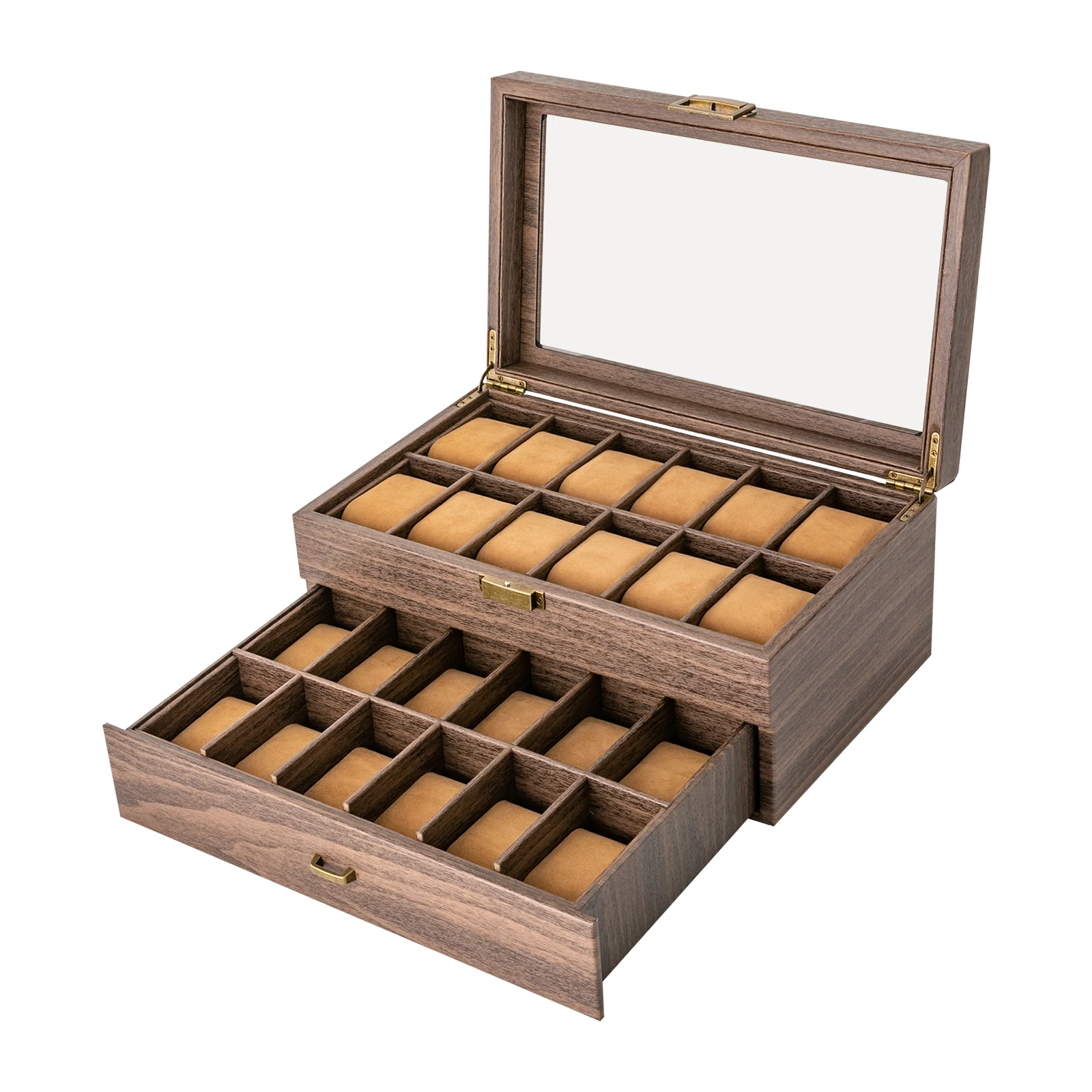
Programming Your Watch Winder: Step-by-Step Guide
Follow these steps to properly program your watch winder for optimal performance:
Pre-Programming Preparation
Manually wind your watch first: Before placing your watch on the winder, manually wind it (if possible) by turning the crown approximately 20-30 times to establish a base power reserve.
Check watch mounting: Secure your watch on the winder cushion or holder, ensuring it’s neither too tight (causing stress on the bracelet/strap) nor too loose (allowing unwanted movement).
Verify watch orientation: Most winders are designed to hold watches in either a vertical or horizontal position. For standard winders, the 12 o’clock position should typically face upward or to one side.
Universal Programming Steps
Power on the winder: Connect the power adapter and turn on the winder using the main power switch.
Access programming mode: Depending on your winder model, press the program/mode/setting button to enter the setup interface.
Select TPD setting: Navigate to the TPD option and choose the appropriate setting for your watch based on your research. Start with the lower end of the recommended range if you’re unsure.
Choose rotation direction: Set the direction to clockwise, counter-clockwise, or bi-directional according to your watch’s requirements.
Set rest interval pattern: If your winder offers rest interval programming, configure the active and rest periods as desired.
Confirm and save settings: Press the confirm/save/enter button to lock in your chosen settings.
Verify operation: Watch the winder for a few minutes to ensure it’s rotating in the correct direction and pattern.
Programming Different Winder Types
Basic Switch/Dial Models
- Typically feature physical switches or dials for TPD and direction
- Look for labeled positions indicating different TPD ranges (e.g., 650, 750, 850)
- Direction switches commonly use abbreviations (CW, CCW, BD)
- Select desired positions and ensure switches are firmly in place
Digital Display Models
- Navigate menu options using arrow/navigation buttons
- Select parameters from digital readouts or LED indicators
- Confirm each setting before moving to the next parameter
- Look for a “start” or “run” option after programming is complete
Advanced Programmable Models
- Access preset programs for common watch brands through the menu
- Use custom programming mode for specific requirements
- Save custom programs to memory slots for quick access
- Check for additional features like sleep mode or timed operation
For more detailed instructions on setting up different watch winder models, our how to program watch winder setup guide provides model-specific guidance. If you’re looking for a straightforward solution for a single timepiece, consider our selection of single watch winders.
Programming Multi-Watch Winders: Managing Different Requirements
Collectors with multiple timepieces face a unique challenge: how to properly wind watches with different setting requirements in the same winder. Strategic planning can help optimize your multi-watch winder programming.
When dealing with multiple watches that have different winding needs, consider these effective strategies:
Group similar watches together: Place watches with similar TPD and directional requirements in the same multi-winder or on the same module of a modular winder system.
Use a compromise setting for mixed collections: When winding watches with different requirements on a single-program winder, opt for a middle TPD setting and bi-directional rotation. For example, if one watch needs 650 TPD and another needs 850 TPD, a setting of 750 TPD with bi-directional rotation will adequately serve both.
Rotate positions strategically: If your collection includes watches that wind only in one direction, place these in winder positions programmed for that specific direction, while keeping bi-directional winders for watches that accept both directions.
Prioritize complicated watches: If you have limited individually programmable winder positions, give priority to watches with complications like perpetual calendars or moon phases, as these benefit most from consistent winding.
For winders with individually programmable rotors, you have the advantage of customizing each position. Program each slot according to the specific watch it will hold, and consider creating a reference chart to remember which watch belongs in which position.
Some collectors develop rotation systems where watches are moved between winder and watch box on a schedule. This approach works well if you have more watches than winder positions, allowing you to keep everything in good condition with limited winder capacity.
For more information on managing watches with different movement requirements, our guide on adjusting watch winder movements provides detailed strategies for collection management.
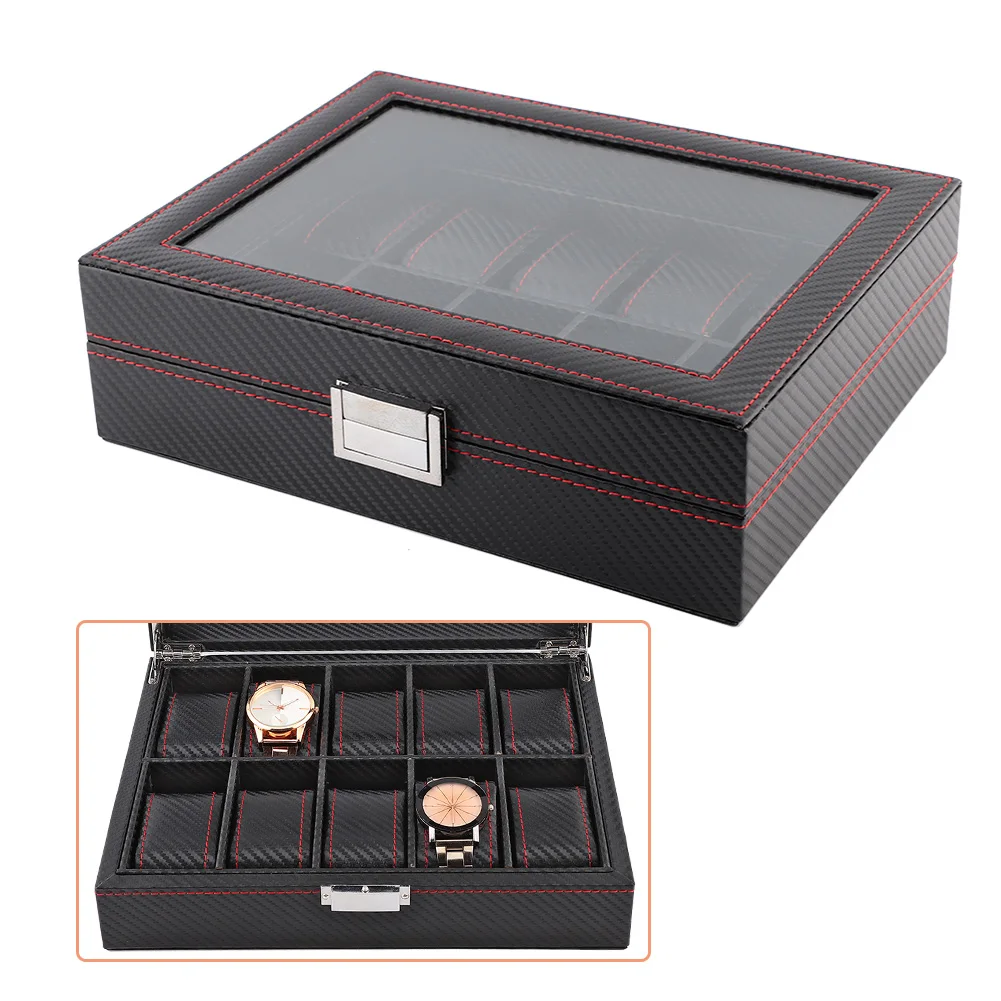
Fine-Tuning Your Settings: The Observation Method
When manufacturer recommendations aren’t available or you want to optimize your settings further, the observation method provides a systematic approach to finding the perfect winder settings for your timepiece.
Step-by-Step Observation Process
Start Conservative: Begin with modest settings—650 TPD and bi-directional rotation with standard rest intervals.
Set Precise Time Reference: Synchronize your watch with an accurate time source such as time.gov or a radio-controlled clock.
Initial Monitoring Period: Place your watch on the winder for 48-72 hours without wearing it.
Record Baseline Performance: Check if the watch maintains accurate time and doesn’t stop. Note any time gained or lost during this period.
Incremental Adjustments: If the watch stops or loses significant time, increase the TPD by 50-100 units. If accuracy is good, you’ve found your baseline.
Second Monitoring Period: Test the new settings for another 48-72 hours and record results.
Direction Experimentation: If performance isn’t optimal with bi-directional settings, try exclusive clockwise or counter-clockwise rotation if your watch supports it.
Final Refinement: Make additional small adjustments until you find the minimum TPD setting that keeps your watch running accurately.
When monitoring your watch’s performance, look for these indicators of insufficient winding:
– The watch stops completely before the end of the testing period
– Time accuracy deteriorates significantly over the test period
– The power reserve indicator (if present) shows consistent decline
For optimal record-keeping, create a simple log with columns for:
– Date
– TPD setting
– Direction setting
– Rest interval pattern
– Time accuracy (seconds gained/lost per day)
– Notes on performance
This methodical approach helps identify the most efficient settings for your specific timepiece, accounting for its unique characteristics and condition. Even watches of the same model can have slightly different optimal settings based on their service history and age.
For collectors with specialized storage needs, our watch organizer solutions can complement your winding system for complete collection management.
Advanced Optimization: Environmental Factors and Placement
The environment surrounding your watch winder significantly impacts both winder performance and watch longevity. Consider these key environmental factors when positioning your winder:
Temperature Considerations
The ideal temperature range for watch winders is 65-75°F (18-24°C). This range helps maintain proper lubrication viscosity in both your watches and the winder motor. Excessive heat can cause lubricants to thin and potentially leak, while cold temperatures may cause them to thicken and increase friction.
Humidity Management
Keep relative humidity between 40-60% around your watch winder. Excessive humidity can lead to condensation inside watch cases and potential corrosion of movement components. Too little humidity may cause certain components to dry out prematurely. Consider using silica gel packets near your winder if you live in a particularly humid environment.
Vibration and Stability
Place your winder on a solid, level surface that doesn’t experience frequent vibrations. Constant minor vibrations from nearby appliances or foot traffic can affect both the winder’s performance and potentially the watch’s accuracy. Anti-vibration pads can help isolate the winder from environmental vibrations.
Light Exposure
Avoid placing winders in direct sunlight or under harsh artificial lighting. Prolonged UV exposure can fade watch dials and degrade straps or bracelets. Additionally, heat from direct light sources can affect temperature stability.
Optimal Placement Recommendations
- Surface stability: Choose a solid wood surface or dedicated shelf rather than lightweight or unstable furniture.
- Magnetic isolation: Keep winders at least 12 inches away from speakers, smartphones, tablets, and other magnetic sources that could affect watch movements.
- Ventilation space: Allow at least 3 inches of clearance around all sides of the winder for proper air circulation to prevent overheating.
- Accessibility considerations: Position the winder where you can easily see the control panel and access the watches without awkward reaching or bending.
For collectors who also display their watches when not in use, our watch display holders offer attractive solutions that complement your winding system while adhering to these environmental best practices.
Troubleshooting Common Programming Issues
Even with careful setup, watch winder programming issues occasionally arise. Here’s how to diagnose and solve common problems:
Watch Stops Despite Being on Winder
First Checks:
– Verify the winder is actually running (some operate silently)
– Confirm TPD setting isn’t too low for your watch’s requirements
– Check if the watch has reached the end of its power reserve initially
Solutions:
1. Increase TPD setting by 100-150 turns
2. Change rotation direction or switch to bi-directional
3. Manually wind watch fully before placing on winder
4. Check for magnetization of watch movement (affects performance)
Significant Time Gain/Loss While on Winder
First Checks:
– Note exact rate of gain/loss (seconds per day)
– Check if watch position on cushion has shifted
– Verify winder is level and stable
Solutions:
1. Try different orientation (vertical vs. horizontal mounting)
2. Adjust cushion size if watch is rotating unevenly
3. If gaining/losing more than 20 seconds daily, watch may need service
4. Test watch accuracy off the winder to determine if the winder is affecting timekeeping
Incorrect Number of Rotations
First Checks:
– Count actual rotations over a timed period (e.g., one hour)
– Check if winder display matches actual operation
– Verify power source is stable
Solutions:
1. Reset winder to factory settings and reprogram
2. Check for firmware updates if winder is digital
3. Contact manufacturer if rotation count is significantly off specifications
4. Consider power conditioning if electrical supply is inconsistent
Direction Settings Not Working Properly
First Checks:
– Observe actual rotation pattern for several minutes
– Check if bi-directional setting is alternating correctly
– Verify direction selection buttons/switches are functioning
Solutions:
1. Clean contact points on mechanical switches
2. Perform hard reset on digital models
3. Test alternate direction settings to isolate the problem
4. Check for obstruction in rotation mechanism
Inconsistent Winding Performance
First Checks:
– Monitor winder operation throughout different times of day
– Check if rest intervals are functioning properly
– Verify watch is properly seated on cushion
Solutions:
1. Adjust cushion size or tension
2. Remove and reinstall watch, ensuring proper mounting
3. Test winder with a different watch to isolate the issue
4. Check for timer/programming errors in rest cycle settings
For more comprehensive troubleshooting assistance, refer to our detailed guide on troubleshooting common watch winder problems, which covers additional issues and model-specific solutions.
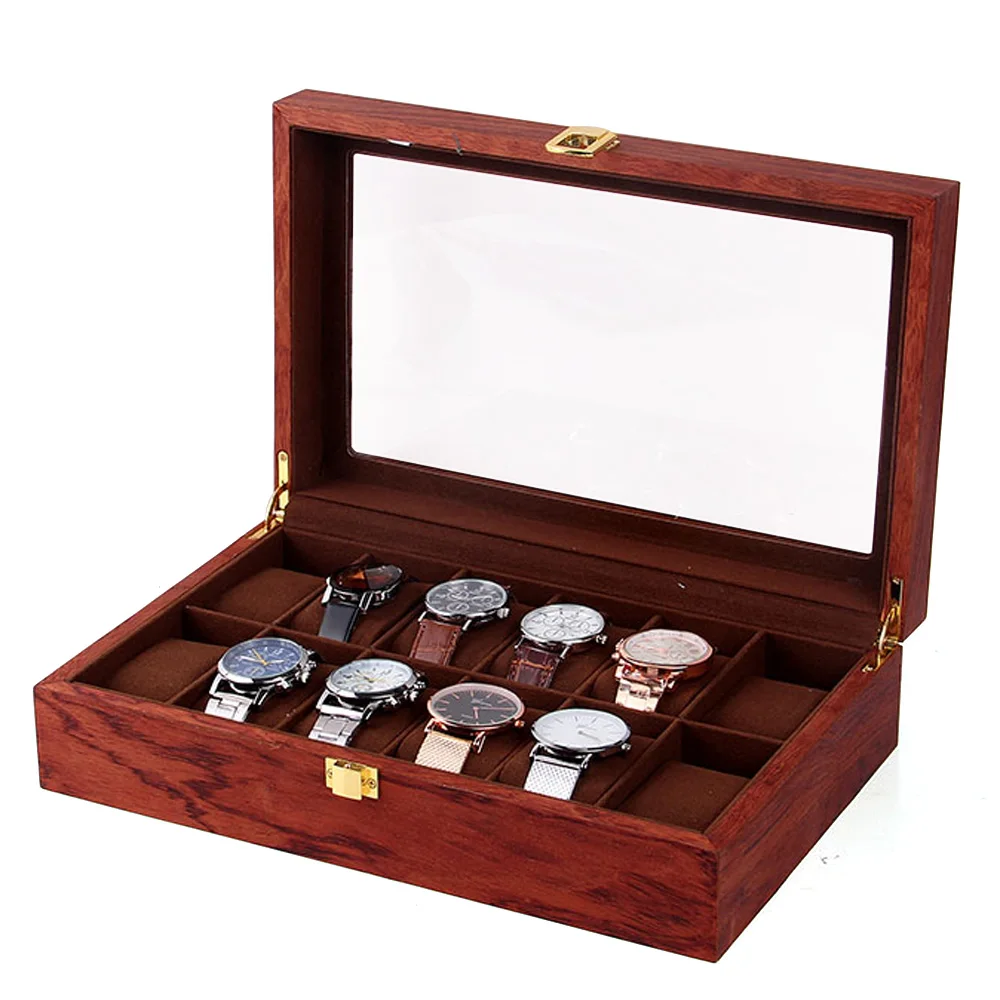
Smart and Bluetooth-Enabled Winder Programming
The latest generation of watch winders incorporates smart technology and connectivity features that transform the programming experience. These advanced winders offer unprecedented control and convenience for the modern collector.
Smart watch winders typically feature:
- App-based interfaces that allow programming through smartphones or tablets
- Comprehensive watch databases with pre-configured settings for hundreds of watch models
- Real-time monitoring of winder status, rotation counts, and operation time
- Custom program creation with more precise control over TPD, direction, and intervals
- Multiple user profiles for collectors who share winders with family members
- Usage statistics to track winder efficiency and watch performance
- Firmware updates that add new features and watch compatibility
The primary advantage of connected winders is precision. Rather than selecting from preset TPD ranges (such as 650, 750, 850), smart winders often allow exact specification (e.g., 723 TPD) to perfectly match manufacturer recommendations. Similarly, rest interval programming can be fine-tuned to the minute rather than using predefined cycles.
For optimal setup of smart winders:
– Place the winder within strong Bluetooth or Wi-Fi range
– Keep the companion app updated to the latest version
– Create backups of your custom programs
– Use secure passwords if the app requires account creation
The technology continues to evolve, with upcoming features likely to include integration with watch collecting apps, maintenance reminders based on winding patterns, and more sophisticated power management systems.
For collectors interested in optimizing their watch rotation schedules, our guide on perfect rotation cycles for automatic watches provides additional insights into leveraging smart winder capabilities.
Watch Accessories, Watch Holder
$94.51 Select options This product has multiple variants. The options may be chosen on the product pageMen's Watch Organizer, Watch Display Case, Watch Organizer
Price range: $112.68 through $169.45 Select options This product has multiple variants. The options may be chosen on the product pageAutomatic Watch Winder, Luxury Watch Winder, Single Watch Box
$307.39 Select options This product has multiple variants. The options may be chosen on the product pageRotating Watch Holder, Watch Holder
Price range: $93.28 through $93.35 Select options This product has multiple variants. The options may be chosen on the product page4 Watch Winder, 6 Watch Box, Automatic Watch Winder
$512.31 Select options This product has multiple variants. The options may be chosen on the product pageAutomatic Watch Winder, Single Watch Winder, Wooden Watch Holder
$201.76 Select options This product has multiple variants. The options may be chosen on the product page
Does My Watch Need a Winder? Assessing Your Requirements
Before investing time in programming a watch winder, it’s worth considering whether your specific collection and wearing habits actually necessitate one. Use these evaluation criteria to determine if a winder is right for you:
When Watch Winders Provide Greatest Benefit
Watch Complexity
Winders are particularly valuable for watches with perpetual calendars, annual calendars, moon phases, or other complications that are time-consuming to reset if they stop.
Wearing Rotation
If you rotate between multiple watches but want each to be ready to wear without setting, a winder keeps your entire collection ready for immediate use.
Irregular Wearing Patterns
For watches worn occasionally but that you want ready at a moment’s notice, a winder maintains accuracy and functionality between wearings.
Collection Size
As collections grow beyond 3-4 watches, the time investment in manually winding and setting each piece becomes significant, making winders increasingly practical.
When Manual Winding Might Be Preferable
Simple Watch Design
For time-only or simple date watches that are quick to set, the benefits of a winder may be minimal.
Daily Wear Habits
If you wear the same watch daily or only have one automatic watch, a winder is less necessary.
Movement Health Considerations
Some collectors prefer to let watches wind down periodically to allow parts to rest, though this remains debated among experts.
Environmental Concerns
The power consumption of a winder may be a consideration for environmentally conscious collectors.
For collectors with two watches who alternate between them regularly, a double watch winder offers an efficient solution. Understanding watch winder motor specifications can also help you make an informed decision about the quality and longevity of potential winder purchases.
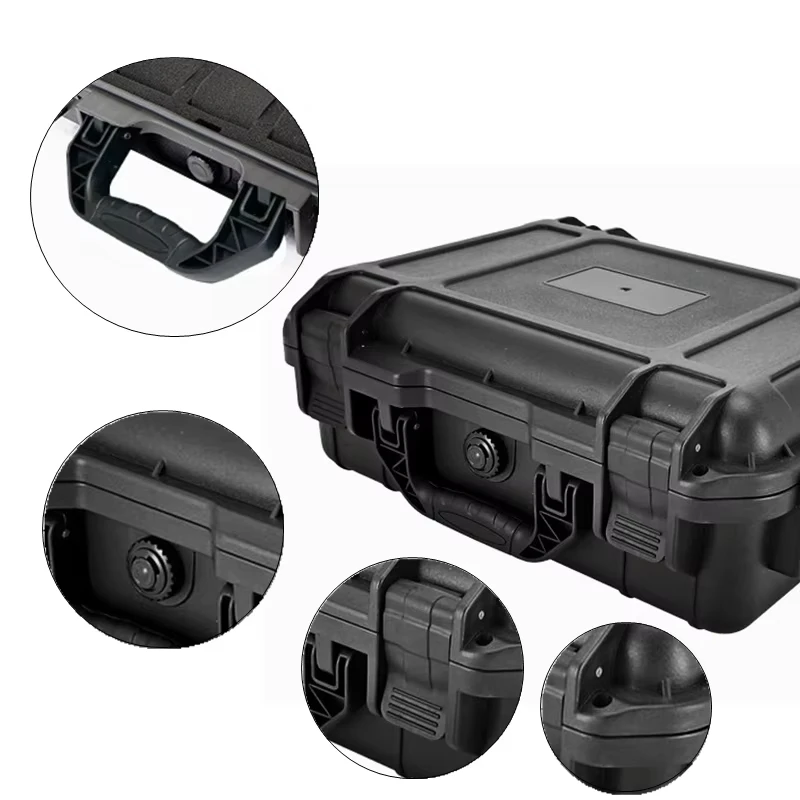
Frequently Asked Questions About Watch Winder Programming
Can incorrect winder settings damage my automatic watch?
Modern automatic watches have built-in protection against overwinding, so excessive TPD settings typically won’t cause damage. However, using incorrect settings is inefficient and may result in your watch not maintaining proper power reserve. Vintage watches without these protections require more careful setting.
How often should I change my winder’s programming?
For most collectors, once you’ve established optimal settings for your watch, you shouldn’t need to change the programming unless you notice performance issues or switch to a different watch. Seasonal adjustments are generally unnecessary.
Can I use one general setting for all my watches?
While a moderate setting (around 800 TPD with bi-directional rotation) will adequately serve most modern watches, it’s not optimal for every timepiece. Watches with specific directional requirements or unusual power reserve characteristics benefit from customized settings.
Is it normal for my watch to lose some accuracy on the winder?
A small variation in accuracy between wrist-wearing and winder use is normal. Your body movement and temperature affect performance differently than a winder does. However, significant accuracy changes (more than 10-15 seconds per day difference) may indicate improper settings or other issues.
Should my watch winder run continuously or with breaks?
Intermittent operation with programmed rest periods is generally preferred as it better mimics natural wearing patterns, reduces power consumption, and extends the life of your winder’s motor. However, continuous operation won’t harm most modern watches.
Will using a winder reduce how long my automatic watch lasts before servicing?
When properly programmed, a winder shouldn’t significantly impact service intervals. Some watchmakers even suggest that keeping a movement running prevents lubricants from settling, potentially extending time between services, though this remains debated among experts.
For additional storage solutions that complement your winding system, explore our rotating watch holders that offer alternative display options with movement functionality.
Master Your Watch Winder: Key Takeaway Points
Programming your watch winder correctly is essential for maintaining your automatic timepieces in optimal condition. Remember these key principles as you care for your collection:
Match TPD specifically to your watch – The ideal setting is the minimum TPD needed to maintain power reserve, not the maximum your winder offers. Start with manufacturer recommendations and fine-tune based on observation.
Direction settings should align with movement design – Know whether your watch winds in one direction or both, and program accordingly. When in doubt, bi-directional offers the safest approach for most modern watches.
Rest periods enhance efficiency – Intermittent winding with programmed rest intervals more closely mimics natural wear patterns and extends winder motor life.
Environmental factors matter – Temperature, humidity, vibration, and positioning all affect both winder performance and watch longevity. Create stable conditions for optimal results.
Documentation improves outcomes – Keep records of effective settings for each watch in your collection to eliminate guesswork and streamline future programming.
By taking a methodical approach to watch winder programming, you ensure your treasured timepieces receive precisely the care they need. This attention to detail preserves not only their accuracy and functionality but also protects your investment for years to come.
The perfect balance of technical precision and practical application will keep your automatic watches ready to wear whenever you reach for them—the ultimate goal of any well-programmed watch winder system.

